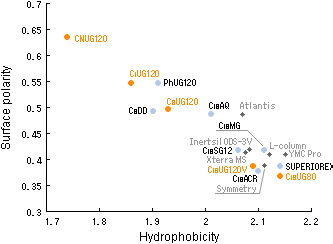
|
|
UG stands for "Ultra Grade." The packing material is produced from high-purity silica with fine polymer coating achieved by Osaka Soda unique surface treatment technology. The UG series includes types of various different functional
groups to make full use of excellent separation characteristics.
|
|
|
|
 |
|
Low-polarity UG Series
|
The non-polar surface allows quick and sharp elution of polar compounds. Since various functional groups are supported, the retention and selectivity can be varied by replacing the column, even under the same mobile phase. The UG80,
the type of large retention and high loadability, is also available, suited for preparative use, too.
|
|
|
 |
|
Features
|
|
|
· Sharp elution of basic, coordinating, and acidic compounds with no tailing. Quick and sharp elution of polar compounds.
|
|
|
|
|
|
· Low column pressure
|
|
→
|
Narrow particle diameter distribution by extremely precise classification
|
|
|
|
|
|
|
· Extended pH range
|
|
→
|
Polymer coating technology allows the pH range 2-10. Excellent durability. (NH
2 : pH 2 to 8, SCX: pH 2 to 7).
|
|
|
|
|
|
|
· Excellent lot reproducibility
|
|
→
|
Validation-supporting silica ensuring stable quality through strict manufacturing control.
|
|
|
|
· Supporting GLP/GMP
|
|
→
|
Certificates attached to C
18UG120S5 (i.d.: 3.0, 4.6 mm), C
18UG80 (i.d.: 4.6 mm), and C
18UG120V (i.d.: 2.0, 1.5, 1.0 mm)
|
|
|
|
|
|
|
· Grades for preparative use lined up
|
|
→
|
UG120 (particle size: 5, 20, 30 µm) and also UG80 (Particle size: 5, 20 µm) optimum for preparative use with high loadability
|
|
|
|
|
|
|
· Complete lineup of functional groups
|
|
|
|
|
|
· Full range of column sizes
|
|
→
|
A complete lineup from microcolumns of 0.3 mm i.d. to preparative columns
|
|
|
|
· Also available worldwide
|
|
|
 |
|
Property values
|
|
|
Pore size
(nm)
|
Particle size
(µm)
|
Specific surface area
(m
2/g)
|
C%
|
Density
(µmol/m
2)
|
Functional group
|
Acceptable pH
|
USP
|
|
|
12
|
3
|
300
|
15
|
2.3
|
Octadecyl group
|
2~10
|
L1
|
|
|
12
|
5
|
300
|
15
|
2.3
|
Octadecyl group
|
2~10
|
L1
|
|
|
12
|
20
|
310
|
-
|
-
|
Octadecyl group
|
2~10
|
L1
|
|
|
12
|
30
|
330
|
15
|
2.1
|
Octadecyl group
|
2~10
|
L1
|
|
|
8
|
5
|
340
|
18
|
2.5
|
Octadecyl group
|
2~10
|
L1
|
|
|
8
|
20
|
550
|
17
|
1.4
|
Octadecyl group
|
2~10
|
L1
|
|
|
12
|
5
|
300
|
9
|
3.1
|
Octyl group
|
2~10
|
L7
|
|
|
12
|
5
|
300
|
8
|
3.7
|
Phenyl group
|
2~10
|
L11
|
|
|
12
|
5
|
300
|
4
|
11.1
|
Methyl group
|
2~10
|
L13
|
|
|
12
|
5
|
300
|
5
|
13.9
|
Nitrile group
|
2~10
|
L10
|
|
|
8
|
5
|
540
|
14
|
1.2
|
Amino group
|
2~8
|
L8
|
|
|
8
|
5
|
450
|
9
|
0.9
|
Sulfonic group
|
2~7
|
L9
|


